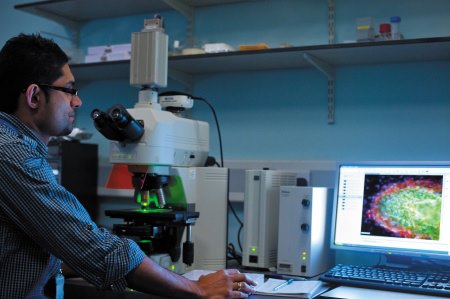
Case Studies
These case studies demonstrate some of the benefits of our pervious Digital Research programmes of work, which delivered several new services to our research community. More examples of the work undertaken within Digital Research can be found on the Digital Research Blog (http://blogs.nottingham.ac.uk/digitalresearch/category/digital-research-case-studies/)
Ancient Trees – UoN Compute Service
Ancient trees are ecologically, historically and culturally important, and although we know the locations of many, there are plenty more to be discovered. Victoria Nolan, a PhD candidate at the University of Nottingham is using mathematical models to produce predictions of likely suitable areas for ancient trees allowing her to carry out target surveys to locate them and add them to a distribution map. Improving the accuracy of the map will enable better protection and policy measures to be put in place for ancient trees, and prevent further decline.
Digital Research Service used: Compute and Analytics, on-site Higher Performance Computer
Difference made: Victoria commented, “we have been using species distribution modelling to predict ancient tree presence/ absence across a small sample area of the UK at a 1km resolution using many different environmental and topographical predictors, and have fitted models that successfully are able to predict suitability and find undiscovered ancient trees. Upscaling these models across the whole of the UK at the same resolution on a standard desktop computer proved to be extremely difficult due to the large number of calculations required for each grid square. Using the University of Nottingham Compute Service has allowed us to compute the model predictors at a much faster rate, which will allow me to fit the models. This in turn will allow me to design field surveys based on the predictions to be carried out in 2020 within the span of my PhD, something which otherwise would have been impossible.”
Containerising and scaling applications using Kubernetes and Microsoft Azure
July 2019

Context: Dr Gary Mirams is a Wellcome Trust Senior Research Fellow and member of the Centre for Mathematical Medicine & Biology (CMMB) in the School of Mathematical Sciences, where he constructs mathematical and computational models to describe biological processes.
Mathematical models offer a way to describe the evolution of a heart cell’s electrical activity due to the interaction of the different ionic currents. The heart’s pumping action is driven by the flow of these electrically charged particles, which can be blocked by pharmaceutical compounds. Gary has developed ApPredict – free open source software to enable non-mathematicians/modellers to perform these simulations. However, installing and configuring a suitable software environment for ApPredict is a complex task relying on a specific operating system and software dependencies, resulting
in the development of ApPortal – a web-based interface to a pre-existing, shared instance of ApPredict. The challenge was to maximise use of the software by making it available in a form that can be easily and quickly deployed by UoN as a scalable service for others, or as a private service within external organisations such as pharmaceutical companies.
Geoff took an approach now common in industry, and carried out an “exercise in separating out what needs and can be scaled”, placing these components into a collection of containers (virtual operating systems). Containers can be run on a much wider variety of hardware, providing greater flexibility about where ApPredict might be deployed. Recognising that releasing a usable service is “not just putting things in containers”, Geoff then developed a proof-of-concept using Kubernetes - an open-source container-orchestration system3 – to demonstrate how a group of complimentary applications (including ApPredict and ApPortal) can be automatically deployed, scaled and destroyed without server management expertise. Gary and Geoff are now continuing to document the Kubernetes version of the ApPredict suite to allow its release.
Digital Research Service(s) used: Compute and Analytics – Cloud Computing environment - Azure Kubernetes Service (AKS)4.
Difference made:
- ApPredict can be deployed on any cloud or local hardware that supports Kubernetes, a much wider selection than the non-containerised version (currently Ubuntu only if using a package manger). Enables the possibility for UoN to run ApPredict as a service on Azure for internal/external users, and external parties to deploy their own instances if necessary (e.g. private instances).
- 2) Greater scope for scaling the cluster or individual ApPredict containers based on needs of specific use cases, making ApPredict more cost-effective in terms of computing infrastructure for anyone hosting the software.
- Simplified installation process, requiring little to no server managem
ent expertise, reducing burden on Gary to provide technical support to external parties wishing to deploy the software.
- Geoff and Gary gained practical experience of use of AKS and feasibility of containerising mathematical models/simulations as an approach for other research and impact projects.
Effective collaboration and data management using Microsoft OneNote
July 2019
Context: Associate Professor Alan McIntyre (School of Medicine) leads a research group that studies the effects of hypoxia (low levels of oxygen) in the context of molecular and cell biology, with a focus on cancerous tumours. The research generates large amounts of raw and processed data in multiple formats. Both supervisors and collaborators need regular access to the data.
The challenge was to design a way of capturing and sharing data that both saves time and safeguards against loss, damage, and experiment irreproducibility.
Response: Digital copies of all lab notebooks are now uploaded to OneNote and shared between members of the group. Sections can be added to the notebooks for organising meetings, keeping track of spending, and managing grants. Raw and processed data files are linked through OneDrive, where researchers store data individually in folders shared with the supervisor.
Digital Research Service(s) used: Office 365 (OneNote).
Difference made:
1) Supervisors can now access lab notebooks remotely.’
2) Being able to combine multiple types of data into one format makes it much easier to share those data as well as manage different aspects of the project (data storage, protocols, meetings, expenditure) in a single and easily accessible place.
3) Having digital copies of experiment protocols makes reproducing experiments easy.